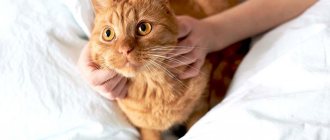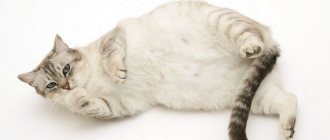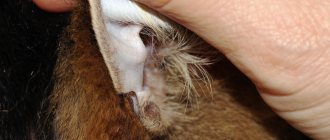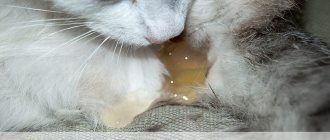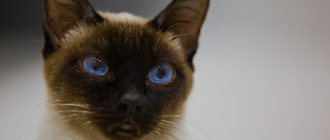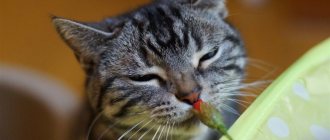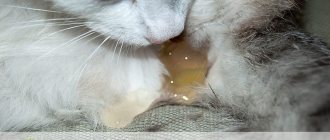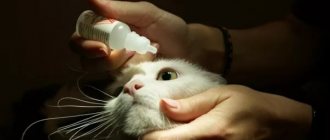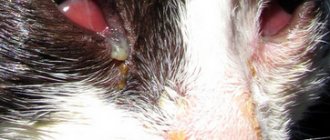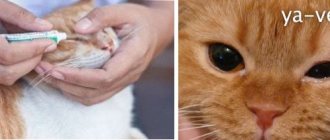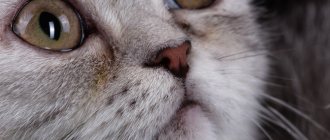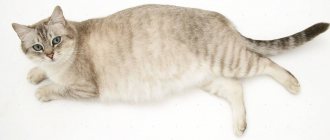Normally, cats always secrete a small amount of clear secretion from their eyes - it cleans the eyeballs of dust and foreign bodies. However, sometimes the color of the discharge takes on a brown tint. Then the cat will have unsightly marks and dark crusts under its eyes. Let's find out whether this is normal or pathological, and in what cases the help of a veterinarian is needed.
Cosmetic defect
Brown discharge from the corners of the eyes in cats is not always a sign of pathology. The cornea is constantly washed by tear fluid, but under certain circumstances it becomes larger.
The amount of discharge increases in strong winds, due to bright light, if the cat is in a dusty or smoky room.
The tear fluid contains substances that, when exposed to ultraviolet radiation, acquire a brownish tint. Dark discharge is most noticeable in the following cats:
- with light coat color;
- with a flattened muzzle;
- in older individuals;
- in emotional pets - when they purr, they produce copious amounts of tears or saliva.
Minor discharge, which over time turns into dried brown crusts, is not a pathology and does not threaten the cat in any way. This is just a cosmetic defect. Brown marks are usually removed using daily hygiene products.
Attention! You should not wipe your cat's eyes with hydrogen peroxide. If it comes into contact with the mucous membrane, the solution may cause irritation and discomfort.
Symptoms - how to understand that your cat is sick.
There are many unpleasant diseases that can affect your pet's vision. It is important to recognize them in time and seek qualified help, because the lack of treatment or untimely intervention by a specialist will aggravate the situation and even lead to complete or partial loss of the pet’s vision.
You should be seriously concerned about the condition of your furry friend if you notice the following symptoms:.
- Brown discharge from a cat's eyes, often mixed with pus, indicates the presence of a bacterial infection in the animal's body. Additional symptoms in this case may include lethargy and nasal discharge.
- Clear discharge, as well as abundant and thick discharge, warns you of a viral infection.
- Brown discharge most often appears when the tear ducts malfunction.
- If a cat has swollen eyes and waters with ordinary tears, without any admixture of pus, but in large quantities, she sneezes and itches, then most likely this is an allergic reaction. This disease is also heralded by redness of the eyelids and their swelling.
- Reddish discharge from the eyes can easily be confused with brown if the cat has a dark fur color.
- Watch his reaction to others - is the cat making contact or has he become unsociable?
- Has his appetite changed?
- Check for scratches and other mechanical damage near the eyes.
- Try to find out what color the discharge from the pet’s eyes is, and whether there is any admixture of pus in it.
Perhaps they are not so pronounced, and it is difficult for you to decide what exactly is bothering your pet. In this case, it is worth observing his behavior.
If all these symptoms are absent in your case, and the cat’s eyes are watering with ordinary transparent tears, then there is no reason to panic. There are a number of reasons why even a healthy animal can have watery eyes. This is an unsuitable diet, characteristics of the breed, an allergic reaction to certain components or substances.
Types of pathological discharge from the eyes
During pathological processes, cats develop discharge that differs in color and consistency:
- Transparent. If your cat's eyes are watery but a colorless liquid exudate is coming out, this may be a sign of an allergy.
- White or light yellow. Such discharge most often occurs due to a viral or fungal infection.
- Saturated yellow or greenish (purulent) is a sign of infection with pathogenic bacteria.
- Brown or reddish discharge with a thick consistency. This color indicates that they contain red blood cells.
Causes of discharge
Exudate from the eyes is characteristic of several ophthalmological diseases:
- Inflammation of the mucous wall of the eye - conjunctivitis . The disease manifests itself as redness of the conjunctiva, sometimes they become red with a brown or bluish tint. Conjunctivitis also causes photophobia, itching in the eye sockets, and profuse mucous or purulent discharge from the eyes. In this case, the conjunctival mucosa has varying degrees of damage (wounds or ulcers).
- Increased production of tears - epiphora . This pathology is usually the result of an allergy to some irritant or an instinctive reaction aimed at the speedy elimination of a foreign body that has penetrated the visual organ. In pathological cases, epiphora occurs when the lacrimal duct is obstructed.
- Inflammation of the choroid of the eye - uveitis . The disease develops as a result of various infectious and/or invasive infections and is characterized by discharges of different consistency and color.
- Inflammation of the cornea - keratitis . Viscous yellowish or greenish discharge is indicative of it. At the same time, the eyes run, the eyelids often stick together and become overgrown with crusts.
Causes of discharge from eyes in cats
There are many reasons why a cat has brown discharge coming from its eyes. The problem can be caused by injury, infection, inflammation or even a tumor.
Impaired outflow of tear fluid
Dacryocystitis is one of the possible causes of bloody discharge in the corners of the eyes. This is a pathology in which the passage of tear fluid through the nasolacrimal duct becomes difficult.
The reasons for obstruction are as follows:
- Inflammation of the walls of the lacrimal canal, which leads to its narrowing and blockage. As a result, fluid stagnation occurs. A pathogenic microflora develops in the lacrimal sac, and a mucous secretion mixed with blood begins to be released from the corners. The inflammatory process is accompanied by redness of the eye and discomfort. The cat becomes restless.
- Narrowing of the lacrimal opening, or stenosis. This pathology occurs in cats, which often suffer from conjunctivitis. The chronic inflammatory process helps to reduce the diameter of the lacrimal opening. As a result, fluid constantly accumulates in the eye and flows out from the inner corner. Stenosis can be not only acquired, but also congenital. In this case, the problem can only be solved through surgery.
- Injury. During active play on the street or at home, cats sometimes bump into sharp objects and injure their eyes. When the eyelids are torn or cut, the tear duct often suffers. In this case, black discharge appears from the eye because the tear fluid contains a large amount of blood. It is important to seek help from a veterinarian immediately. If necessary, he will stitch the eyelid and help restore the patency of the nasolacrimal duct.
- Tumor. If the eye becomes less mobile and hurts, and brown tears flow from the corner, this may be caused by a benign or malignant neoplasm. The presence of blood in the tear fluid indicates tissue damage. Only surgery will help with the tumor. For eye cancer, treatment with chemotherapy is mandatory.
- Foreign body in the lacrimal canal. Motes such as grains of sand, dust particles, and insects can get into a cat's eyes. Together with tears, small foreign bodies sometimes penetrate the ducts of the nasolacrimal canal, which leads to its blockage and inflammation. The cat feels discomfort when blinking and tries to wash its eye with its paw. This causes even more irritation. Treatment involves removing the foreign body by washing or bougienage, as well as the use of local antiseptics.
Infectious diseases
Inflammation of the eyes, which is often accompanied by copious brown discharge, may be one of the symptoms of an infectious disease:
- chlamydia;
- toxoplasmosis;
- panleukopenia;
- calcivirosis;
- rhinotracheitis.
With such serious illnesses, the cat’s health deteriorates. She becomes lethargic, loses appetite, body temperature rises, and her coat looks unkempt. With some infectious diseases, kittens bleed not only from the eyes, but also from the nose. The eyelids become swollen and red.
Attention! If such symptoms are detected, you should immediately seek veterinary help. If left untreated, your cat may die from a viral infection.
Brown discharge also appears with ophthalmological diseases, which can be caused by a bacterial, viral or fungal infection. These include:
- conjunctivitis – inflammation of the mucous membrane of the eye;
- blepharitis – eyelash follicles are affected;
- keratitis – inflammation of the cornea;
- anterior uveitis - infection affects the blood vessels of the eyes.
In all of these cases, a sick cat may develop brown tears from one or both eyes if the inflammation has affected the vessels and capillaries.
Other pathologies
Cats sometimes have watery eyes due to problems with their internal organs. Diabetes mellitus, kidney, liver or intestinal diseases are often accompanied by brown discharge from the organs of vision. Also, a similar problem occurs when infected with helminths.
In rare cases, tearing occurs due to dietary errors, for example, when a cat owner feeds her dry and wet food at the same time.
In Sphynxes and Cornish Rexes there is such a pathology as entropion of the eyelid, in which brown discharge also flows from the eyes. Long-haired cats “cry” when hairs get on the mucous membrane of the eyeball.
Attention! Eyes can fester in any animal, regardless of their gender or age. However, cat breeds with a flattened face - Scottish, British and Persian - are especially susceptible to this pathology, because they have a shortened nasolacrimal duct.
Prevention
Prevention consists of monitoring and caring for your pet. Most breeds do not require intervention, however, in the case of cats with flattened faces, it is necessary to remove the discharge when it appears. The natural secretion, when dried and oxidized, forms a good environment for the growth of bacteria. This increases the risk of developing diseases.
Eye diseases in kittens! Herpes of the eye and calicivirus in cats.
To prevent discharge, it is recommended not to give your cat sweets. Animals metabolize sugar worse than humans. Some of the breakdown products enter the bloodstream and cause a reaction from the immune system. This causes discharge from the eyes, itching and redness of the skin.
All information posted on the site is provided in accordance with the User Agreement and is not a direct instruction to action. We strongly recommend that before using any product, you must obtain a face-to-face consultation at an accredited veterinary clinic.
Diagnostics
If the owner notices brown discharge around the cat's eyes, he needs to take the pet to a veterinary clinic. In most cases, examination and history is sufficient to make a diagnosis.
Sometimes it is necessary to conduct additional tests to help rule out head and eye injuries, as well as diseases of internal organs and infectious diseases. To do this you may need to do:
- Ultrasound of the organs of vision;
- X-ray of the skull;
- blood and stool tests.
Wet eyes are normal
If the owner notices discharge from the eyes of cats in the form of a light, transparent liquid, there is no need to panic. This is completely normal for a healthy animal. Wet eyes can occur both after sleep and throughout the day.
But if the owner regularly observes purulent or colored discharge, this is a serious cause for alarm.
For example, you notice a brown discharge from your cat’s eyes. What could this mean? Or, say, if the animal has greenish discharge? Now let's look at this in detail.
Treatment and prevention
Depending on the cause of inflammation, the veterinarian develops a treatment regimen for the cat:
- In some cases, local therapy using drops or ointments with antimicrobial, analgesic and anti-inflammatory effects is sufficient.
- If brown discharge appears due to congenital pathology of the eyelids, surgery is recommended.
- Surgery cannot be avoided when a cat has an eye tumor.
- If the tear ducts are clogged or blocked, rinsing helps, but if they are narrowed, surgery may be necessary.
- If a kitten is diagnosed with an infectious disease, one of the symptoms of which is purulent eyes with brown discharge, then the pet is treated not only with eye drops, but with antiviral drugs and immunostimulants.
- For helminthiasis, which is accompanied by tearing, antiparasitic drugs are used.
Types of eye drops for cats
In most cases, treatment for brown discharge involves the use of topical eye medications. These include drops and ointments. They are divided into 3 groups - antimicrobial, antibacterial and antiviral (immunomodulatory).
Antiseptic drops
Antiseptics can be used for the prevention and treatment of ophthalmic diseases:
- Ophthalmosan. A preparation based on chlorhexidine and succinic acid. These components inhibit the development of pathogenic microflora. For brown discharge in cats, use 2-3 times a day, 2 drops under the lower eyelid. The duration of the course of treatment is determined by the veterinarian.
- Lacrican. The main component is the antiseptic polysept, which prevents the proliferation of microbes. The drug also contains anesthesin, a substance with an analgesic effect. After preliminary cleaning of brown discharge, 2 drops of medicine are injected under the cat’s lower eyelid. The procedure is carried out 2 or 3 times a day for 8–10 days.
Antibacterial drops
These are drugs that destroy gram-positive and gram-negative bacteria - chlamydia, mycoplasma, staphylococcus, Pseudomonas aeruginosa, etc. These microorganisms cause inflammation of the organs of vision, which is accompanied by purulent and brown discharge. List of medications for cats:
- Tsiprovet. It is prescribed for acute or chronic conjunctivitis, keratitis, blepharitis, and corneal ulcers. The active ingredient is ciprofloxacin. Directions for use and dosage for cats: 1 drop in each eye 4 times a day; the course of treatment for brown discharge is 1–2 weeks (until complete recovery).
- Dekta-2. The active ingredient here is gentamicin. It has a wide spectrum of antibacterial action. The medicine also contains dexamethasone, a glucocorticosteroid. This is an anti-inflammatory component. Directions for use: 2-3 drops into the conjunctival sac of the eye 2-3 times a day. The course of treatment is from 5 to 10 days.
- Lakrimin aseptic. Broad-spectrum eye drops based on chloramphenicol and sodium sulfosalicylate. The drug is used for eye diseases with purulent discharge, as well as for postoperative complications and wounds of the eyelids or cornea. Directions for use: 2-3 drops 2-3 times a day for 5-7 days.
Immunomodulatory
This group includes cat drops, which are indicated for use in eye diseases caused by viral infections:
- Anandin. The drops have an immunomodulatory, anti-inflammatory and regenerating effect. For brown or purulent discharge under the cat's eyelid, administer 2 drops of medication in the morning and evening. The course of treatment is from 5 to 7 days.
- Maxidin. The drug is based on an organic compound of germanium, which has high antiviral activity, and also has an anti-inflammatory and regenerating effect. Drops are used to treat conjunctivitis and keratitis of an infectious and allergic nature. Directions for use: 1 or 2 drops under each eyelid 2 times a day until the symptoms of the disease disappear.
How to rinse and apply eye drops at home
Before using medicinal products, it is necessary to clean the cat's eyelids of brown discharge. To carry out the procedure, you will need the help of another person, because the cat will struggle. It is necessary to prepare in advance clean cotton pads (5-6 pieces for each eye), as well as a means for hygienic treatment:
- strained chamomile decoction;
- furatsilin solution – 1 tablet per glass of water;
- weak solution of boric acid.
If none of the above is at hand, you can rinse your eyes with warm boiled water. A cotton pad is generously moistened and gently wiped over the cat's eyelids in the direction from the outer corner of the eye to the inner.
Dirty sponges are put aside - you need to take a clean one every time. It is important to remove all brown discharge and crusts. Only after this the eyes are instilled with a medicinal composition.
Attention! The eyelid cleaning procedure is carried out before each use of eye drops.
Treatment of the disease
If a cat has brown discharge from its eyes, it must be taken to a veterinary clinic as quickly as possible. Treatment methods are different and depend on the cause of the pathology, so a thorough diagnosis is first made.
If you have to wait until the main treatment is prescribed, the owner can use home anti-inflammatory therapy. It consists of washing the eyes with antibacterial solutions prepared independently. Suitable for washing are: boiled water, strong tea leaves, furatsilin solution, boric acid solution.
Washing should be carried out as follows:
- secure the kitten firmly, holding it by the paws;
- Dip a cotton swab into the solution, and, parting the eyelids, squeeze the excess liquid into the eye;
- in case of eyelids sticking together, carefully soak the crusts by briefly applying a damp swab to the eyelids;
- rinse the eye, simultaneously removing discharge, with movements in the direction from the outer to the inner corner of the eye;
- Always treat both eyes, changing tampons.
Prevention of eye discharge should consist of observing the rules of eye hygiene and general hygiene, maintaining immunity at a high level, timely deworming, and proper feeding. All these measures are a necessary condition for maintaining the cat’s ophthalmological health. And healthy eyes mean a cheerful, active, beautiful pet for many years.
Once again about transparent discharge
We have already mentioned above the profuse tearing of cat’s eyes. Now let us dwell in more detail on the issue of transparent discharge from the eyes of cats and the symptoms that accompany them. What should you pay attention to?
- If you notice clear discharge from your nose and eyes, this should alert you. A clear sign that the cat has calcivirus.
- The cat is lethargic, refuses to eat and tries to hide in a dark place.
- The collar and mouth are constantly wet due to the abundant secretion of saliva.
- Small ulcers filled with fluid appear in the mouth. They burst, causing the cat great pain and unable to eat.
- The animal is constantly sneezing.
- Sores similar to those in the mouth appear on the nose.
Contact your veterinarian immediately. This is a very serious infection, and if it is not stopped in time, there is a high probability of your pet’s death.
Causes of the disease
Blepharitis refers to inflammation of the edges of the eyelids. There are several types of the disease. The most common are simple (scaly), ulcerative, and meibomian.
There can be many reasons that cause blepharitis in cats:
- Viruses and bacteria, most often pyogenic cocci.
- Helminthic infestations.
- Subcutaneous mites. In this case, in addition to the eyelids, the neck and face of the animal are affected.
- Pathogens (fungi) of trichosporia and microsporia.
- Allergic reaction of the body to food, pollen, etc.
- Eye injuries received during a fight or as a result of self-scratching.
- Seborrhea. When the functions of the sebaceous glands are disrupted, dandruff and scales appear on the eyelids.
- Autoimmune and endocrine pathologies.
- Violation of hygiene standards.
And this is not a complete list of factors that provoke such an unpleasant eye disease as blepharitis.
How to treat?
We never tire of repeating that we first determine the cause of purulent discharge. Before your veterinarian gets involved, you can help your cat at home. Relieve pus and discomfort with chamomile infusion, saline solution or antiseptic without alcohol.
Here you will need help from your household. One holds the pet, the second washes the eye. Take a cotton swab, twist it tightly and dip it in the solution. Squeeze onto the animal's eyelid.
If the eyes are glued together, then the solution is applied to the surface. Soon the eyes will open and it will be possible to wash them. If the eyelashes are stuck together, then the eye is rubbed with the solution over the surface until it opens. Cleaning is carried out with a cotton swab, moving to the corners of the eyes.
What does an owner need to know before rinsing a cat's eye?
- The solution should be warm. Do not use a product that is too hot or cold.
- When treating eyes, change cotton swabs as often as possible.
- It is strictly necessary to ensure that the tampon is wet. Contact of the eye with a dry swab is unacceptable. The material may stick to the surface of the eye, causing damage.
It is quite possible that the veterinarian will prescribe drops in the cat’s eyes for purulent discharge. Please do not use them yourself, without prescription from a specialist. This can be fraught with very serious consequences.
What drops are most often prescribed?
- "Diamond Eyes" Relieves inflammation. Prescribed for various diseases of the organs of vision.
- "Leopard". If a cat has purulent conjunctivitis, it is possible to prescribe these drops. They are inexpensive but effective. Suitable for all breeds.
- "Iris". Prescribed for corneal erosion. Excellent for treating conditions such as keratitis (eyelids) and blepharitis (swollen eyelids). Sometimes doctors prescribe drops for prevention.
- "Levomycetin". Kills all bacteria outright. Suitable for the treatment of conjunctivitis.
Drops are instilled into the cat's eyes as follows. Position the animal's head so that the eyes look up. The pipette is held at a distance of 2 cm from the eye and dripped. It is advisable to have someone help hold the pet during the procedure.
Pink discharge
Let's start with the fact that if your pet is a representative of the Persian breed, then you do not need to be afraid of such discharge. Pink discharge from the eyes in cats is associated with the structure of the nose and eyes.
In other cases, pinkish-brown discharge may indicate trichiasis. This is abnormal eyelash growth. It provokes a violation of the structure of the eyelids. As in the previous case, it is important to contact your veterinarian for help in a timely manner. The owner is powerless in this situation.
Causes
In normal condition, the animal's eyeball is constantly moistened with tear fluid. It protects it from infections and foreign bodies.
In a healthy cat, waste fluid enters the nasal canal and evaporates. If it begins to accumulate, darkens, and acquires an unpleasant odor, this indicates an infection of the eyes and inflammation of the tear ducts.
Dacryocystitis
With this pathology, there is a violation of the outflow of tear fluid through the excretory canal.
Reasons due to which this problem occurs:
- inflammatory process;
- chronic conjunctivitis;
- entry of a foreign body into the lacrimal canal;
- injuries to the eye, eyelids, head;
- oncological neoplasms;
- allergy;
- everted eyelid.
As soon as the cause of dacryocystitis is established, the veterinarian prescribes treatment in each specific case.
The inflammatory process is controlled with the help of medications. In all other cases, surgical intervention is required. In cases of cancer, the pet undergoes chemotherapy.
Inflammation of the tear duct due to infections
Blockage of the duct can occur due to conjunctivitis, iridocyclitis, keratitis, blepharitis. These are infectious diseases, mechanical injuries to the eyes that cause damage to the eyelids, ciliary bulbs, cornea, and iris.
Antibacterial therapy is used for all types of lesions. In some cases, antiviral and antifungal drugs are used. If the disease is advanced, ointments based on hormones are used.
What to do at home
A caring owner must provide the pet with complete peace and proper living conditions. Under no circumstances should you select medications on your own, since very often blepharitis is confused with conjunctivitis.
The owner, bypassing going to the veterinary clinic, buys the drops himself, washes the animal’s eyes with herbal infusions and strong tea, but for some reason nothing helps. This is not surprising, because they are treating him for one disease, but he needs to fight something completely different. And often such self-medication leads to very unpleasant consequences and complications, including loss of vision.
Traditional medicine methods can be used, but they should not replace drug treatment prescribed by a veterinarian. It is advisable to use various herbal decoctions (chamomile, calendula, St. John's wort, sage), "Fitoelite" phytolotions, and wash your eyes with a decoction of hyssop.
Phytomineral feeding will also not be superfluous. It is also necessary to strengthen the immune system so that the body has the strength to fight the disease.
Infectious diseases
The first sign of infection is discharge from the eyes of cats. Greenish, milky and yellow discharge indicates the presence of the following diseases:
- Bacterial conjunctivitis.
- Inflammation of the eyelids.
- Diseases of the ocular vessels.
- Inflammation of the cornea of the eye.
- Glaucoma.
What to do in this case? Alas, when it comes to a bacterial infection, you simply cannot do without the help of a veterinarian. The longer you delay with it, the higher the likelihood of developing pathology. Fighting it is much harder than killing the disease in the bud.
Brown discharge
Let us warn you right away: this is not an infection. Most likely, brown discharge is associated with impaired tear outflow. What pathologies and diseases are indicated by brown discharge from the eyes of cats? The list is:
- Small tear ducts.
- Eye injury.
- Non-infectious inflammation of the lacrimal sac.
- Allergy.
- Neoplasms compressing the tear ducts.
- Foreign body in the lumen of the lacrimal canal.
Only a veterinarian can make an accurate diagnosis. Self-treatment can only aggravate the situation, leading to irreversible consequences.
By the way, about brown discharge. Very rare, but they are associated with improper feeding. Many owners are aware that they cannot feed their pet dry food and homemade food at the same time. One thing should be in the diet. But they still continue to do this.
If this is how you feed your cat, try removing the kibble or regular food. After a few days, the discharge will disappear on its own. If this does not happen, you will have to go to the vet.
